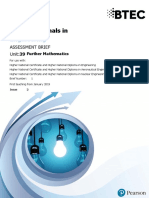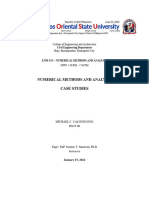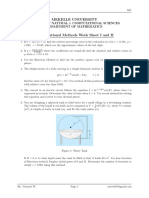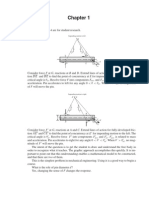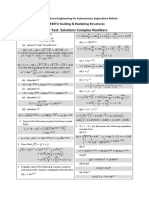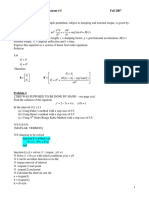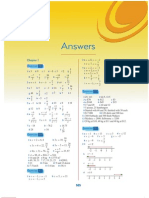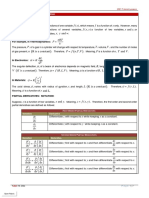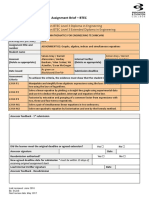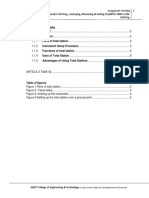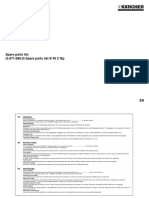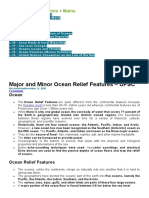Assignment Working 1
BSc(Hons) in Civil Eng.; Further Mathematics For construction/BTEC HND in
CBE-Civil Eng
TABLE OF CONTENT
PART 1...............................................................................2-5
PART 2...............................................................................6-9
PART 3………………………………………………………..10
PART 4…………………………………………………… 11-20
Table number Content Page
Table 1 Hourly data flow rate values 11
Table 2 Half-hourly data flow rate 14
values
Table 3 6min data values flow rate 19-20
values
Table 4 Compared found trapezoidal 20
and rectangular values
ESOFT College of Engineering & Technology To Learn and to Apply for the Betterment of Humanity
� Assignment Working 2
BSc(Hons) in Civil Eng.; Further Mathematics For construction/BTEC HND in
CBE-Civil Eng
PART 1
Figure 1: section of the road network in the downtown area
Section A
Traffic in = 𝑥1 + 𝑥2
Traffic out = 400 + 225
∴ 𝒙𝟏 + 𝒙𝟐 = 625vph
Section B
Traffic in = 350 + 125
Traffic out = 𝑥1 + 𝑥4
∴ 𝒙𝟏 + 𝒙𝟒 = 475vph
Section C
Traffic in = 𝑥3 + 𝑥4
Traffic out = 600 + 300
∴ 𝒙𝟑 + 𝒙𝟒 = 900vph
Section D
Traffic in = 800 + 250
Traffic out = 𝑥2 + 𝑥3
ESOFT College of Engineering & Technology To Learn and to Apply for the Betterment of Humanity
� Assignment Working 3
BSc(Hons) in Civil Eng.; Further Mathematics For construction/BTEC HND in
CBE-Civil Eng
∴ 𝒙𝟐 + 𝒙𝟑 = 1050vph
𝑥1 + 𝑥2 = 625
𝑥1 + 𝑥4 = 475
𝑥3 + 𝑥4 = 900
𝑥2 + 𝑥3 = 1050
Using matrix
1 1 0 0 𝑥1 625
1 0 0 1 𝑥2 475
[ ] [𝑥 ] = [ ]
0 0 1 1 3 900
0 1 1 0 𝑥4 1050
𝐴𝑥 𝑏
𝐴−1𝐴𝑥 = 𝑏𝐴−1
𝑥 = 𝐴−1𝑏
Here we can’t find 𝐴−1
Using matlab
>> A = (1 1 0 0; 1 0 0 1; 0 0 1 1; 0 1 1 0)
Inv (A)
Ans. =
Inf Inf Inf Inf
Inf Inf Inf Inf
Inf Inf Inf Inf
Inf Inf Inf Inf
now we use elementary row operations
1 1 0 0 625 𝑅1
1 0 0 1 475 𝑅2
0 0 1 1 900 𝑅3
0 1 1 0 1050 𝑅4
ESOFT College of Engineering & Technology To Learn and to Apply for the Betterment of Humanity
� Assignment Working 4
BSc(Hons) in Civil Eng.; Further Mathematics For construction/BTEC HND in
CBE-Civil Eng
1 1 0 0 625 𝑅1′ = 𝑅1
0 1 0 −1 150 𝑅2′ = 𝑅1 − 𝑅2
0 0 1 1 900 𝑅3′ = 𝑅3
0 1 1 0 1050 𝑅4′ = 𝑅4
1 1 0 0 625 𝑅1′′ = 𝑅1′
0 1 0 −1 150 𝑅2′′ = 𝑅2′
0 0 1 1 900 𝑅3′′ = 𝑅3′
0 0 1 1 900 𝑅4′′ = 𝑅4′ − 𝑅2′
1 1 0 0 625 𝑅1′′′ = 𝑅1′′
0 1 0 −1 150 𝑅2′′′ = 𝑅2′′
0 0 1 1 900 𝑅3′′′ = 𝑅3′′
0 0 0 0 0 𝑅4′′′ = 𝑅4′′ − 𝑅3′′
1 0 0 1 475 𝑅1′′′′ = 𝑅1′′′ − 𝑅2′′′
0 1 0 −1 150 𝑅2′′′′ = 𝑅2′′′
0 0 1 1 900 𝑅3′′′′ = 𝑅3′′′
0 0 0 0 0 𝑅4′′′′ = 𝑅4′′′
Using above row operations
𝑥1 + 𝑥4 = 475
𝑥2 - 𝑥4 = 150
𝑥3 + 𝑥4 = 900
The road sections are one way, using pervious equations
𝑥1 + 𝑥4 = 475 1
𝑥2 - 𝑥4 = 150 2
𝑥3 + 𝑥4 = 900 3
Here road sections are one way
𝑥1 , 𝑥2 , 𝑥3 , 𝑥4 ≥ x
ESOFT College of Engineering & Technology To Learn and to Apply for the Betterment of Humanity
� Assignment Working 5
BSc(Hons) in Civil Eng.; Further Mathematics For construction/BTEC HND in
CBE-Civil Eng
From 3 for x, to minimum 𝑥4 has to be maximum and equal,
𝑥4 ≤ 900
From 1 the maximum value of 𝑥4 is 475. Hence, from 3 the minimum of 𝑥3 is,
𝑥3 = -475 +900
𝑥3 = 425
Hence, at least 425vph should be allowed on the Monroe street.
Apply equation “2”
𝑥2 =625
Hence, at least 625vph should be allowed on the Hogan street.
Apply equation “1”
𝑥1 =0
Hence, at least 0vph should be allowed on the Duval street.
ESOFT College of Engineering & Technology To Learn and to Apply for the Betterment of Humanity
� Assignment Working 6
BSc(Hons) in Civil Eng.; Further Mathematics For construction/BTEC HND in
CBE-Civil Eng
PART 2
Figure 2: 3D force balance system where a 150kg crate is supported by three
cables
Position vector
⃗⃗⃗⃗⃗ = −6𝑖 + 3𝑗 + 2𝑘
𝐴𝐵
⃗⃗⃗⃗⃗ | =√(−62 + 32 + 22
|𝐴𝐵
⃗⃗⃗⃗⃗ | = 7
|𝐴𝐵
Unit vector
⃗⃗⃗⃗⃗
𝐴𝐵 −6𝑖 + 3𝑗 + 2𝑘
=
⃗⃗⃗⃗⃗⃗⃗⃗⃗
|𝐴𝐵| √ 62 + 32 + 22
𝐹𝐵 = [−0.8571𝑖 + 0.4286𝑗 + 0.2857𝑘]𝐹𝐵
𝐹𝐵 = −0.8571𝑖𝐹𝐵 + 0.4286𝑗𝐹𝐵 + 0.2857𝑘𝐹𝐵
ESOFT College of Engineering & Technology To Learn and to Apply for the Betterment of Humanity
� Assignment Working 7
BSc(Hons) in Civil Eng.; Further Mathematics For construction/BTEC HND in
CBE-Civil Eng
Position vector
⃗⃗⃗⃗⃗
𝐴𝐶 =−6𝑖 − 2𝑗 + 3𝑘
⃗⃗⃗⃗⃗ | =√(−62 ) + (−22 ) + 32
|𝐴𝐶
⃗⃗⃗⃗⃗ | = 7
|𝐴𝐶
Unit vector
⃗⃗⃗⃗⃗
𝐴𝐶 6𝑖 − 2𝑗 + 3𝑘
=
⃗⃗⃗⃗⃗⃗⃗⃗
|𝐴𝐶| √ 62 + (−22 ) + 22
𝐹𝐶 = [0.8571𝑖 − 0.2857𝑗 + 0.4286𝑘]𝐹𝐶
𝐹𝐶 = 0.8571𝑖𝐹𝐶 − 0.2857𝑗𝐹𝐶 0.4286𝑘𝐹𝐶
Position vector
⃗⃗⃗⃗⃗
𝐴𝐷 =1𝑖 + 0𝑗 + 0𝑘
⃗⃗⃗⃗⃗ | =√12 + 02 + 02
|𝐴𝐷
⃗⃗⃗⃗⃗ | = 1
|𝐴𝐷
Unit vector
⃗⃗⃗⃗⃗
𝐴𝐷 𝑖
=
⃗⃗⃗⃗⃗⃗⃗⃗⃗
|𝐴𝐷| √ 12
𝐹𝐷 = [𝑖]𝐹𝐷
𝐹𝐷 = 𝑖𝐹𝐷
Position vector
⃗⃗⃗⃗⃗
𝐴𝐸 =0𝑖 + 0𝑗 − 1𝑘
⃗⃗⃗⃗⃗ | =√02 + 02 + (−12 )
|𝐴𝐸
⃗⃗⃗⃗⃗ | = 1
|𝐴𝐸
Unit vector
ESOFT College of Engineering & Technology To Learn and to Apply for the Betterment of Humanity
� Assignment Working 8
BSc(Hons) in Civil Eng.; Further Mathematics For construction/BTEC HND in
CBE-Civil Eng
⃗⃗⃗⃗⃗
𝐴𝐸 −𝑘
=
⃗⃗⃗⃗⃗⃗⃗⃗
|𝐴𝐸| √ 12
−𝑘
𝐹𝐸 = [ ] 𝐹𝐸
√ 12
𝐹𝐸 = −𝑘𝐹𝐸
𝐹𝐸 = −150 × 9.81
𝐹𝐸 = (−𝟏𝟒𝟕𝟏. 𝟓𝒌)𝑵
Considering the equation
∑ 𝑓𝑥 ; −0.8571𝐹𝐵 − 0.8571𝐹𝐶 + 𝐹𝐷 = 0 1
∑ 𝑓𝑦 ; 0.4286𝐹𝐵 −0.2857𝐹𝐶 + 0 = 0 2
∑ 𝑓𝑧; 0.2857𝐹𝐵 +0.4286𝐹𝐶 − 1471.5 = 0 3
Now we calculate these forces with a matrix.
−0.8571 −0.8571 1 𝐹𝐵 0
[ 0.4286 −0.2857 0] [ 𝐹𝐶 ] = [ 0 ]
0.2857 0.4286 0 FD 1471.5
A 𝑥 b
𝐴−1 𝐴𝑥 = 𝑏𝐴−1
𝒙 = 𝑨−𝟏 𝒃 4
now we calculate 𝐴−1;
|𝐴| = −0.8571 |−0.2857 0 − (−0.8571) 0.4286 0 0.4286 −0.2857|
| | |+1|
0.4286 0 0.2857 0 0.2857 0.4286
|𝐴| = −0.8571(0) + 0.8571(0) − 1(0.4286 × 0.4286 − 0.2857(−0.2857))
|𝐴| = 0 + 0 − 0.2653
|𝐴| = 0.2653
−0.8571 0.4286 0.2857
𝐴𝑇 = [ −0.8571 −0.2857 0.4286 ]
1 0 0
ESOFT College of Engineering & Technology To Learn and to Apply for the Betterment of Humanity
� Assignment Working 9
BSc(Hons) in Civil Eng.; Further Mathematics For construction/BTEC HND in
CBE-Civil Eng
0 0.4286 0.2857
𝐴𝑎𝑑𝑗 =[ 0 −0.2857 0.4285 ]
0.2652 0.1224 0.6121
1
𝐴−1 = × 𝐴𝑎𝑑𝑗
|𝐴|
0 0.4285 0.2857
[ 0 −0.2857 0.4285 ]
𝐴−1 = 0.2652 0.1224 0.6121
0.2653
Apply “4” equation
𝒙 = 𝑨−𝟏 𝒃
𝐹𝐵 0 1.6154 1.0768 0
[ 𝐹𝐶 ] = [ 0 −1.0768 1.6154 ] [ 0 ]
𝐹𝐷 1 0.4616 2.3075 1471.5
𝐹𝐵 1584.6435
𝐹
[ 𝐶 ] = [ 2377.11 ]
𝐹𝐷 −3395.5280
FB = 1584.6435N
FC = 2377.11N
FD = -3395.5280N
While we consider 𝐹𝐷 ↓ direction, we get minus answer. When we consider 𝐹𝐷 with ↑
direction we can get positive answer.
↑ 𝑭𝑫 = 𝟑𝟑𝟗𝟓.𝟓𝟐𝟖𝟎𝑵
ESOFT College of Engineering & Technology To Learn and to Apply for the Betterment of Humanity
� Assignment Working 10
BSc(Hons) in Civil Eng.; Further Mathematics For construction/BTEC HND in
CBE-Civil Eng
PART 3
Given data:
𝑥1 − 𝑥2 = 1500𝑓𝑡
𝐷 = 16𝑖𝑛𝑐ℎ
𝑓 = 0.03
𝑣 2 𝑓𝑙
𝐻𝑠 = 𝑥1 − 𝑥2 + 2𝑔 𝐷
Use 𝑄 = 𝐴𝑣 equation
𝑄
Here v =
𝐴
𝜋𝐷 2
A=
4
1 162
A = 4 𝜋 122
By substituting for v
𝑄 2 0.03 ×1500
𝐻𝑠 = 120 + 2𝐴2 𝑔 (16⁄12)
𝐻𝑠 = 120 + 1.335𝑄 2
When 𝐻𝑠 in ft and Q in 103 gal/min
a) substituting Q = 15, required pump head is 𝐻𝑠 ,
𝐻𝑠 = 120 + 1.335 × 152
𝑯𝒔 = 𝟒𝟐𝟎. 𝟑𝟕𝟓𝒇𝒕
b) 32-inch diameter
c) Pump efficiency =82%
rpm =1170rpm
d)
e) Wire to water efficiency=73.8%
f) Approximate horse power 2000bhp
ESOFT College of Engineering & Technology To Learn and to Apply for the Betterment of Humanity
� Assignment Working 11
BSc(Hons) in Civil Eng.; Further Mathematics For construction/BTEC HND in
CBE-Civil Eng
Part 04
Polynomial function:
𝑄(𝑡) = 𝑡3 − 7.88𝑡2 + 15.71𝑡 𝑚3/ℎ𝑟
0 ≤ 𝑡 ≤ 5 ℎ𝑟
Now calculate the total liquid flow as.
𝑡 =5
In here we apply t = 0;1;2;3;4;5 values to polynomial function: Q(t) = t3 - 7.88t2 + 15.71t
m3/hr
𝑸(𝒕) = 𝒕𝟑 − 𝟕. 𝟖𝟖𝒕𝟐 + 𝟏𝟓. 𝟕𝟏𝒕 𝒎𝟑/𝒉𝒓
𝑡 = 0;
𝑄(0) = 0 + 0 + 0
𝑸(𝟎) = 𝟎𝒎𝟑/𝒉𝒓
𝑡 = 1;
𝑄(1) = 13 − 7.88 × 12 + 15.71 × 1 𝑚3/ℎ𝑟
𝑸(𝟏) = 𝟖. 𝟖𝟑𝒎𝟑/𝒉𝒓
𝑡 = 2;
𝑄(2) = 23 − 7.88 × 22 + 15.71 × 2 𝑚3/ℎ𝑟
𝑸(𝟐) = 𝟕. 𝟗𝟎𝒎𝟑/𝒉𝒓
𝑡 = 3;
𝑄(3) = 33 − 7.88 × 32 + 15.71 × 3 𝑚3/ℎ𝑟
𝑸(𝟑) = 𝟑. 𝟐𝟏𝒎𝟑/𝒉𝒓
𝑡 = 4;
𝑄(4) = 43 − 7.88 × 42 + 15.71 × 4 𝑚3/ℎ𝑟
𝑸(𝟒) = 𝟎. 𝟕𝟔𝒎𝟑/𝒉𝒓
𝑡 = 5;
𝑄(5) = 53 − 7.88 × 52 + 15.71 × 5 𝑚3/ℎ𝑟
𝑸(𝟓) = 𝟔. 𝟓𝟓𝒎𝟑/𝒉𝒓
Fill table use above values
𝒕 0 1 2 3 4 5
𝑸(𝒕) 0 8.83 7.9 3.21 0.76 6.55
Table 1: hourly data values
ESOFT College of Engineering & Technology To Learn and to Apply for the Betterment of Humanity
� Assignment Working 12
BSc(Hons) in Civil Eng.; Further Mathematics For construction/BTEC HND in
CBE-Civil Eng
Here we should find total liquid flow. Then we use rectangular method to find hourly
liquid flow.
𝐓𝐨𝐭𝐚𝐥 𝐟𝐥𝐨𝐰 𝐥𝐢𝐪𝐮𝐢𝐝 = 𝒉[𝒚(𝒂 + 𝒉) + 𝒚(𝒂 + 𝟐𝒉) + 𝒚(𝒂 + 𝟑𝒉) + … + 𝒚(𝒂 𝒏𝒉)]
Total flow liquid = 1[8.83 + 7.9 + 3.21 + 0.76 + 6.55]
Total flow liquid = 𝟐𝟕. 𝟐𝟓𝟎𝟎𝒎𝟑/𝒉𝒓
Now we use trapezoidal method to find hourly liquid flow.
𝒉
𝐓𝐨𝐭𝐚𝐥 𝐟𝐥𝐨𝐰 𝐥𝐢𝐪𝐮𝐢𝐝 = [𝒚(𝒂) + 𝟐[𝒚(𝒂 + 𝒉) + 𝒚(𝒂 + 𝟐𝒉) + ⋯ + 𝒚(𝒂 + (𝒏 − 𝟏)𝒉)]]
𝟐
1
Total flow liquid = [ 0 + 6.55 + 2[8 .83 + 7.9 + 3.21 + 0.76]]
2
Total flow liquid = 𝟐𝟑. 𝟗𝟕𝟓𝒎𝟑/𝒉𝒓
𝑡 = 5ℎ
0 ≤ 𝑡 ≤ 5 ℎ𝑟
In here we apply t = 0; 0.5; 1; 1.5; 2; 2.5; 3; 3.5 ;4; 4.5; 5 values to polynomial function:
𝑄(𝑡) = 𝑡3 − 7.88𝑡2 + 15.71𝑡 𝑚3/ℎ𝑟
𝑡 = 0;
𝑸(𝟎) = 𝟎𝒎𝟑/𝒉𝒓
𝑡 = 0.5;
𝑄(0.5) = 0.53 − 7.88 × 0.52 + 15.71 × 0.5 𝑚3/ℎ𝑟
𝑸(𝟎. 𝟓) = 𝟔. 𝟎𝟏𝒎𝟑/𝒉𝒓
𝑡 = 1;
𝑄(1) = 13 − 7.88 × 12 + 15.71 × 1 𝑚3/ℎ𝑟
𝑸(𝟏) = 𝟖. 𝟖𝟑𝒎𝟑/𝒉𝒓
𝑡 = 1.5;
𝑄(1.5) = 1.53 − 7.88 × 1.52 + 15.71 × 1.5 𝑚3/ℎ𝑟
𝑸(𝟏. 𝟓) = 𝟗. 𝟐𝟏𝒎𝟑/𝒉𝒓
𝑡 = 2;
𝑄(2) = 23 − 7.88 × 22 + 15.71 × 2 𝑚3/ℎ𝑟
𝑸(𝟐) = 𝟕. 𝟗𝒎𝟑/𝒉𝒓
𝑡 = 2.5;
𝑄(2.5) = 2.53 − 7.88 × 2.52 + 15.71 × 2.5 𝑚3/ℎ𝑟
ESOFT College of Engineering & Technology To Learn and to Apply for the Betterment of Humanity
� Assignment Working 13
BSc(Hons) in Civil Eng.; Further Mathematics For construction/BTEC HND in
CBE-Civil Eng
𝑸(𝟐. 𝟓) = 𝟓. 𝟔𝟓𝒎𝟑/𝒉𝒓
𝑡 = 3;
𝑄(3) = 33 − 7.88 × 32 + 15.71 × 3 𝑚3/ℎ𝑟
𝑸(𝟑) = 𝟑. 𝟐𝟏𝒎𝟑/𝒉𝒓
𝑡 = 3.5;
𝑄(3.5) = 3.53 − 7.88 × 3.52 + 15.71 × 3.5 𝑚3/ℎ𝑟
𝑸(𝟑. 𝟓) = 𝟏. 𝟑𝟑𝒎𝟑/𝒉𝒓
𝑡 = 4;
𝑄(4) = 43 − 7.88 × 42 + 15.71 × 4 𝑚3/ℎ𝑟
𝑸(𝟒) = 𝟎. 𝟕𝟔𝒎𝟑/𝒉𝒓
𝑡 = 4.5;
𝑄(4.5) = 4.53 − 7.88 × 4.52 + 15.71 × 4.5 𝑚3/ℎ𝑟
𝑸(𝟒. 𝟓) = 𝟐. 𝟐𝟓𝒎𝟑/𝒉𝒓
𝑡 = 5;
𝑄(5) = 53 − 7.88 × 52 + 15.71 × 5 𝑚3/ℎ𝑟
𝑸(𝟓) = 𝟔. 𝟓𝟓𝒎𝟑/𝒉𝒓
Here we should find total liquid flow. Then we use rectangular method to find hourly
liquid flow.
𝑇𝑜𝑡𝑎𝑙 𝑙𝑖𝑞𝑢𝑖𝑑 𝑓𝑙𝑜𝑤 = ℎ[𝑦(𝑎 + ℎ) + 𝑦(𝑎 + 2ℎ) + 𝑦(𝑎 + 3ℎ) + … + 𝑦(𝑎 𝑛ℎ)]
𝑇𝑜𝑡𝑎𝑙 𝑙𝑖𝑞𝑢𝑖𝑑 𝑓𝑙𝑜𝑤
= 0.5[6.01 + 8.83 + 9.21 + 7.9 + 5.65 + 3.21 + 1.33 + 0.76 + 2.25 + 6.55]
𝑻𝒐𝒕𝒂𝒍 𝒍𝒊𝒒𝒖𝒊𝒅 𝒇𝒍𝒐𝒘 = 𝟐𝟓. 𝟖𝟓𝒎𝟑 /𝒉
Now we use trapezoidal method to find hourly liquid flow.
ℎ
𝑇𝑜𝑡𝑎𝑙 𝑙𝑖𝑞𝑢𝑖𝑑 𝑓𝑙𝑜𝑤 = [𝑦(𝑎) + 2[𝑦(𝑎 + ℎ) + 𝑦(𝑎 + 2ℎ) + ⋯ + 𝑦(𝑎 + (𝑛 − 1)ℎ)]]
2
𝑇𝑜𝑡𝑎𝑙 𝑙𝑖𝑞𝑢𝑖𝑑 𝑓𝑙𝑜𝑤
0.5
= [ 0 + 6.55 + 2[ 6.01 + 8.83 + 9.21 + 7.9 + 5.65 + 3.21 + 1.33 + 0.76 + 2.25 ]]
2
𝑻𝒐𝒕𝒂𝒍 𝒍𝒊𝒒𝒖𝒊𝒅 𝒇𝒍𝒐𝒘 = 𝟐𝟒. 𝟐𝟏𝒎𝟑/𝒉𝒓
ESOFT College of Engineering & Technology To Learn and to Apply for the Betterment of Humanity
� Assignment Working 14
BSc(Hons) in Civil Eng.; Further Mathematics For construction/BTEC HND in
CBE-Civil Eng
Fill table use above values
t 0 0.5 1 1.5 2 2.5 3 3.5 4 4.5 5
Q(t) 0 6.01 8.83 9.21 7.9 5.65 3.21 1.33 0.76 2.25 6.55
Table 2 : half-hourly data flow rate values
𝑡 =5
In here we apply t = 0; 0.1; 0.2; 0.3; 0.4;0.5;0.6;0.70.8;0.9;1;1.1; …; 5 values to
polynomial function:
𝑸(𝒕) = 𝒕𝟑 − 𝟕. 𝟖𝟖𝒕𝟐 + 𝟏𝟓. 𝟕𝟏𝒕 𝒎𝟑/𝒉𝒓
𝑡 = 0;
𝑸(𝟎) = 𝟎𝒎𝟑/𝒉𝒓
𝑡 = 0.1;
𝑄(0.1) = 0.13 − 7.88 × 0.12 + 15.71 × 0.1 𝑚3/ℎ𝑟
𝑸(𝟎. 𝟏) = 𝟏. 𝟒𝟗𝒎𝟑/𝒉𝒓
𝑡 = 0.2;
𝑄(0.2) = 0.23 − 7.88 × 0.22 + 15.71 × 0.2 𝑚3/ℎ𝑟
𝟖𝟑𝒎𝟑
𝑸(𝟎. 𝟐) = 𝟐.
𝒉𝒓
𝑡 = 0.3;
𝑄(0.3) = 0.33 − 7.88 × 0.32 + 15.71 × 0.3 𝑚3/ℎ𝑟
𝑸(𝟎. 𝟑) = 𝟒. 𝟎𝟑𝒎𝟑/𝒉𝒓
𝑡 = 0.4;
𝑄(0.4) = 0.43 − 7.88 × 0.42 + 15.71 × 0.4 𝑚3/ℎ𝑟
𝑸(𝟎. 𝟒) = 𝟓. 𝟎𝟖𝒎𝟑/𝒉𝒓
𝑡 = 0.5;
𝑄(0.5) = 0.53 − 7.88 × 0.52 + 15.71 × 0.5 𝑚3/ℎ𝑟
𝑸(𝟎. 𝟓) = 𝟔. 𝟎𝟏𝒎𝟑/𝒉𝒓
𝑡 = 0.6;
𝑄(0.6) = 0.63 − 7.88 × 0.62 + 15.71 × 0.6 𝑚3/ℎ𝑟
𝑸(𝟎. 𝟔) = 𝟔. 𝟖𝒎𝟑/𝒉𝒓
𝑡 = 0.7;
𝑄(0.7) = 0.73 − 7.88 × 0.72 + 15.71 × 0.7 𝑚3/ℎ𝑟
𝑸(𝟎. 𝟕) = 𝟕. 𝟒𝟕𝒎𝟑/𝒉𝒓
ESOFT College of Engineering & Technology To Learn and to Apply for the Betterment of Humanity
� Assignment Working 15
BSc(Hons) in Civil Eng.; Further Mathematics For construction/BTEC HND in
CBE-Civil Eng
𝑡 = 0.8;
𝑄(0.8) = 0.83 − 7.88 × 0.82 + 15.71 × 0.8 𝑚3/ℎ𝑟
𝑸(𝟎. 𝟖) = 𝟖. 𝟎𝟑𝒎𝟑/𝒉𝒓
𝑡 = 0.9;
𝑄(0.9) = 0.93 − 7.88 × 0.92 + 15.71 × 0.9 𝑚3/ℎ𝑟
𝑸(𝟎. 𝟗) = 𝟗. 𝟒𝟖𝒎𝟑/𝒉𝒓
𝑡 = 1;
𝑄(1) = 13 − 7.88 × 12 + 15.71 × 1 𝑚3/ℎ𝑟
𝑸(𝟏) = 𝟖. 𝟖𝟑𝒎𝟑/𝒉𝒓
𝑡 = 1.1;
𝑄(1.1) = 1.13 − 7.88 × 1.12 + 15.71 × 1.1 𝑚3/ℎ𝑟
𝑸(𝟏. 𝟏) = 𝟗. 𝟎𝟕𝒎𝟑/𝒉𝒓
𝑡 = 1.2;
𝑄(1.2) = 1.23 − 7.88 × 1.22 + 15.71 × 1.2 𝑚3/ℎ𝑟
𝑸(𝟏. 𝟐) = 𝟗. 𝟐𝟑𝒎𝟑/𝒉𝒓
𝑡 = 1.3;
𝑄(1.3) = 1.33 − 7.88 × 1.32 + 15.71 × 1.3 𝑚3/ℎ𝑟
𝑸(𝟏. 𝟑) = 𝟗. 𝟑𝒎𝟑/𝒉𝒓
𝑡 = 1.4;
𝑄(1.4) = 1.43 − 7.88 × 1.42 + 15.71 × 1.4 𝑚3/ℎ𝑟
𝑸(𝟏. 𝟒) = 𝟗. 𝟐𝟗𝒎𝟑/𝒉𝒓
𝑡 = 1.5;
𝑄(1.5) = 1.53 − 7.88 × 1.52 + 15.71 × 1.5 𝑚3/ℎ𝑟
𝑸(𝟏. 𝟓) = 𝟗. 𝟐𝟏𝒎𝟑/𝒉𝒓
𝑡 = 1.6;
𝑄(1.6) = 1.63 − 7.88 × 1.62 + 15.71 × 1.6 𝑚3/ℎ𝑟
𝑸(𝟏. 𝟔) = 𝟗. 𝟎𝟓𝒎𝟑/𝒉𝒓
𝑡 = 1.7;
𝑄(1.7) = 1.73 − 7.88 × 1.72 + 15.71 × 1.7 𝑚3/ℎ𝑟
𝑸(𝟏. 𝟕) = 𝟖. 𝟖𝟒𝒎𝟑/𝒉𝒓
ESOFT College of Engineering & Technology To Learn and to Apply for the Betterment of Humanity
� Assignment Working 16
BSc(Hons) in Civil Eng.; Further Mathematics For construction/BTEC HND in
CBE-Civil Eng
𝑡 = 1.8;
𝑄(1.8) = 1.83 − 7.88 × 1.82 + 15.71 × 1.8 𝑚3/ℎ𝑟
𝑸(𝟏. 𝟖) = 𝟖. 𝟓𝟕𝒎𝟑/𝒉𝒓
𝑡 = 1.9;
𝑄(1.9) = 1.93 − 7.88 × 1.92 + 15.71 × 1.9 𝑚3/ℎ𝑟
𝑸(𝟏. 𝟗) = 𝟖. 𝟐𝟔𝒎𝟑/𝒉𝒓
𝑡 = 2;
𝑄(2) = 23 − 7.88 × 22 + 15.71 × 2 𝑚3/ℎ𝑟
𝑸(𝟐) = 𝟕. 𝟗𝒎𝟑/𝒉𝒓
𝑡 = 2.1;
𝑄(2.1) = 2.13 − 7.88 × 2.12 + 15.71 × 2.1 𝑚3/ℎ𝑟
𝑸(𝟐. 𝟏) = 𝟕. 𝟓𝒎𝟑/𝒉𝒓
𝑡 = 2.2;
𝑄(2.2) = 2.23 − 7.88 × 2.22 + 15.71 × 2.2 𝑚3/ℎ𝑟
𝑸(𝟐. 𝟐) = 𝟕. 𝟎𝟕𝒎𝟑/𝒉𝒓
𝑡 = 2.3;
𝑄(2.3) = 2.33 − 7.88 × 2.32 + 15.71 × 2.3 𝑚3/ℎ𝑟
𝑸(𝟐. 𝟑) = 𝟔. 𝟔𝟏𝒎𝟑/𝒉𝒓
𝑡 = 2.4;
𝑄(2.4) = 2.43 − 7.88 × 2.42 + 15.71 × 2.4 𝑚3/ℎ𝑟
𝑸(𝟐. 𝟒) = 𝟔. 𝟏𝟑𝒎𝟑/𝒉𝒓
𝑡 = 2.5;
𝑄(2.5) = 2.53 − 7.88 × 2.52 + 15.71 × 2.5 𝑚3/ℎ𝑟
𝑸(𝟐. 𝟓) = 𝟓. 𝟔𝟓𝒎𝟑/𝒉𝒓
𝑡 = 2.6;
𝑄(2.6) = 2.63 − 7.88 × 2.62 + 15.71 × 2.6 𝑚3/ℎ𝑟
𝑸(𝟐. 𝟔) = 𝟓. 𝟏𝟓𝒎𝟑/𝒉𝒓
𝑡 = 2.7;
𝑄(2.7) = 2.73 − 7.88 × 2.72 + 15.71 × 2.7 𝑚3/ℎ𝑟
𝑸(𝟐. 𝟕) = 𝟒. 𝟔𝟓𝒎𝟑/𝒉𝒓
ESOFT College of Engineering & Technology To Learn and to Apply for the Betterment of Humanity
� Assignment Working 17
BSc(Hons) in Civil Eng.; Further Mathematics For construction/BTEC HND in
CBE-Civil Eng
𝑡 = 2.8;
𝑄(2.8) = 2.83 − 7.88 × 2.82 + 15.71 × 2.8 𝑚3/ℎ𝑟
𝑸(𝟐. 𝟖) = 𝟒. 𝟏𝟔𝒎𝟑/𝒉𝒓
𝑡 = 2.9;
𝑄(2.9) = 2.93 − 7.88 × 2.92 + 15.71 × 2.9 𝑚3/ℎ𝑟
𝑸(𝟐. 𝟗) = 𝟑. 𝟔𝟕𝒎𝟑/𝒉𝒓
𝑡 = 3;
𝑄(3) = 33 − 7.88 × 32 + 15.71 × 3 𝑚3/ℎ𝑟
𝑸(𝟑) = 𝟑. 𝟐𝟏𝒎𝟑/𝒉𝒓
𝑡 = 3.1;
𝑄(3.1) = 3.13 − 7.88 × 3.12 + 15.71 × 3.1 𝑚3/ℎ𝑟
𝑸(𝟑. 𝟏) = 𝟐. 𝟕𝟔𝒎𝟑/𝒉𝒓
𝑡 = 3.2;
𝑄(3.2) = 3.23 − 7.88 × 3.22 + 15.71 × 3.2 𝑚3/ℎ𝑟
𝑸(𝟑. 𝟐) = 𝟐. 𝟑𝟒𝒎𝟑/𝒉𝒓
𝑡 = 3.3;
𝑄(3.3) = 3.33 − 7.88 × 3.32 + 15.71 × 3.3 𝑚3/ℎ𝑟
𝑸(𝟑. 𝟑) = 𝟏. 𝟗𝟔𝒎𝟑/𝒉𝒓
𝑡 = 3.4;
𝑄(3.4) = 3.43 − 7.88 × 3.42 + 15.71 × 3.4 𝑚3/ℎ𝑟
𝑸(𝟑. 𝟒) = 𝟏. 𝟔𝟐𝒎𝟑/𝒉𝒓
𝑡 = 3.5;
𝑄(3.5) = 3.53 − 7.88 × 3.52 + 15.71 × 3.5 𝑚3/ℎ𝑟
𝑸(𝟑. 𝟓) = 𝟏. 𝟑𝟑𝒎𝟑/𝒉𝒓
𝑡 = 3.6;
𝑄(3.6) = 3.63 − 7.88 × 3.62 + 15.71 × 3.6 𝑚3/ℎ𝑟
𝑸(𝟑. 𝟔) = 𝟏. 𝟎𝟖𝒎𝟑/𝒉𝒓
𝑡 = 3.7;
𝑄(3.7) = 3.73 − 7.88 × 3.72 + 15.71 × 3.7 𝑚3/ℎ𝑟
𝑸(𝟑. 𝟕) = 𝟎. 𝟗𝒎𝟑/𝒉𝒓
ESOFT College of Engineering & Technology To Learn and to Apply for the Betterment of Humanity
� Assignment Working 18
BSc(Hons) in Civil Eng.; Further Mathematics For construction/BTEC HND in
CBE-Civil Eng
𝑡 = 3.8;
𝑄(3.8) = 3.83 − 7.88 × 3.82 + 15.71 × 3.8 𝑚3/ℎ𝑟
𝑸(𝟑. 𝟖) = 𝟎. 𝟕𝟖𝒎𝟑/𝒉𝒓
𝑡 = 3.9;
𝑄(3.9) = 3.93 − 7.88 × 3.92 + 15.71 × 3.9 𝑚3/ℎ𝑟
𝑸(𝟑. 𝟗) = 𝟎. 𝟕𝟑𝒎𝟑/𝒉𝒓
𝑡 = 4;
𝑄(4) = 43 − 7.88 × 42 + 15.71 × 4 𝑚3/ℎ𝑟
𝑸(𝟒) = 𝟎. 𝟕𝟔𝒎𝟑/𝒉𝒓
𝑡 = 4.1;
𝑄(4.1) = 4.13 − 7.88 × 4.12 + 15.71 × 4.1 𝑚3/ℎ𝑟
𝑸(𝟒. 𝟏) = 𝟎. 𝟖𝟔𝒎𝟑/𝒉𝒓
𝑡 = 4.2;
𝑄(4.2) = 4.23 − 7.88 × 4.22 + 15.71 × 4.2 𝑚3/ℎ𝑟
𝑸(𝟒. 𝟐) = 𝟏. 𝟎𝟔𝒎𝟑/𝒉𝒓
𝑡 = 4.3;
𝑄(4.3) = 4.33 − 7.88 × 4.32 + 15.71 × 4.3 𝑚3/ℎ𝑟
𝑸(𝟒. 𝟑) = 𝟐. 𝟖𝟑𝒎𝟑/𝒉𝒓
𝑡 = 4.4;
𝑄(4.4) = 4.43 − 7.88 × 4.42 + 15.71 × 4.4 𝑚3/ℎ𝑟
𝑸(𝟒. 𝟒) = 𝟏. 𝟕𝟓𝒎𝟑/𝒉𝒓
𝑡 = 4.5;
𝑄(4.5) = 4.53 − 7.88 × 4.52 + 15.71 × 4.5 𝑚3/ℎ𝑟
𝑸(𝟒. 𝟓) = 𝟐. 𝟐𝟓𝒎𝟑/𝒉𝒓
𝑡 = 4.6;
𝑄(4.6) = 4.63 − 7.88 × 4.62 + 15.71 × 4.6 𝑚3/ℎ𝑟
𝑸(𝟒. 𝟔) = 𝟐. 𝟖𝟔𝒎𝟑/𝒉𝒓
𝑡 = 4.7;
𝑄(4.7) = 4.73 − 7.88 × 4.72 + 15.71 × 4.7 𝑚3/ℎ𝑟
𝑸(𝟒. 𝟕) = 𝟑. 𝟓𝟗𝒎𝟑/𝒉𝒓
ESOFT College of Engineering & Technology To Learn and to Apply for the Betterment of Humanity
� Assignment Working 19
BSc(Hons) in Civil Eng.; Further Mathematics For construction/BTEC HND in
CBE-Civil Eng
𝑡 = 4.8;
𝑄(4.8) = 4.83 − 7.88 × 4.82 + 15.71 × 4.8 𝑚3/ℎ𝑟
𝑸(𝟒. 𝟖) = 𝟒. 𝟒𝟒𝒎𝟑/𝒉𝒓
𝑡 = 4.9;
𝑄(4.9) = 4.93 − 7.88 × 4.92 + 15.71 × 4.9 𝑚3/ℎ𝑟
𝑸(𝟒. 𝟗) = 𝟓. 𝟒𝟐𝒎𝟑/𝒉𝒓
𝑡 = 5;
𝑄(5) = 53 − 7.88 × 52 + 15.71 × 5 𝑚3/ℎ𝑟
𝑸(𝟓) = 𝟔. 𝟓𝟓𝒎𝟑/𝒉𝒓
Here we should find total liquid flow. Then we use rectangular method to find hourly
liquid flow.
𝑇𝑜𝑡𝑎𝑙 𝑙𝑖𝑞𝑢𝑖𝑑 𝑓𝑙𝑜𝑤 = ℎ[𝑦(𝑎 + ℎ) + 𝑦(𝑎 + 2ℎ) + 𝑦(𝑎 + 3ℎ) + … + 𝑦(𝑎 𝑛ℎ)]
𝑇𝑜𝑡𝑎𝑙 𝑙𝑖𝑞𝑢𝑖𝑑 𝑓𝑙𝑜𝑤
= 0.1[1.49 + 2.83 + 4.03 + 5.09 + 6.01 + 6.81 + 7.48 + 8.04
+ 8.49 + 8.83 + 9.03 + 9.23 + 9.3 + 9.29 + 9.21 + 9.06
+ 8.85 + 8.58 + 8.26 + 7.9 + 7.5 + 7.07 + 6.61 + 6.14 + 5.65
+ 5.15 + 4.65 + 4.16 + 3.68 + 3.21 + 2.77 + 2.35 + 1.97
+ 1.63 + 1.33 + 1.09 + 0.9 + 0.78 + 0.73 + 0.76 + 0.87
+ 1.07 + 1.36 + 1.75 + 2.25 + 2.86 + 3.59 + 4.44 + 5.43
+ 6.55]
𝑻𝒐𝒕𝒂𝒍 𝒍𝒊𝒒𝒖𝒊𝒅 𝒇𝒍𝒐𝒘 = 𝟐𝟒. 𝟔𝟏𝟏𝒎𝟑 /𝒉𝒓
Again we calculate total liquid flow but now we use trapezoidal method.
ℎ
𝑇𝑜𝑡𝑎𝑙 𝑙𝑖𝑞𝑢𝑖𝑑 𝑓𝑙𝑜𝑤 = [𝑦(𝑎) + 2[𝑦(𝑎 + ℎ) + 𝑦(𝑎 + 2ℎ) + ⋯ + 𝑦(𝑎 + (𝑛 − 1)ℎ)]]
2
𝑇𝑜𝑡𝑎𝑙 𝑙𝑖𝑞𝑢𝑖𝑑 𝑓𝑙𝑜𝑤
0.1
= 2 [0 + 6.55 + 2[1.49 + 2.83 + 4.03 + 5.09 + 6.01 + 6.81 + 7.48 + 8.04 + 8.49 + 8.83
+ 9.03 + 9.23 + 9.3 + 9.29 + 9.21 + 9.06 + 8.85 + 8.58 + 8.26 + 7.9 + 7.5 + 7.07 + 6.61 +
6.14 + 5.65 + 5.15 + 4.65 + 4.16 + 3.68 + 3.21 + 2.77 + 2.35 + 1.97 + 1.63 + 1.33 + 1.09
+ 0.9 + 0.78 + 0.73 + 0.76 + 0.87 + 1.07 + 1.36 + 1.75 + 2.25 + 2.86 + 3.59 + 4.44 +
5.43]]
𝑻𝒐𝒕𝒂𝒍 𝒍𝒊𝒒𝒖𝒊𝒅 𝒇𝒍𝒐𝒘 = 𝟐𝟒. 𝟐𝟖𝟒𝒎𝟑 /𝒉𝒓
Fill table use above values
t 0 0.1 0.2 0.3 0.4 0.5 0.6 0.7 0.8 0.9
Q(t) 0 1.49 2.83 4.03 5.09 6.01 6.81 7.48 8.04 8.49
ESOFT College of Engineering & Technology To Learn and to Apply for the Betterment of Humanity
� Assignment Working 20
BSc(Hons) in Civil Eng.; Further Mathematics For construction/BTEC HND in
CBE-Civil Eng
t 1 1.1 1.2 1.3 1.4 1.5 1.6 1.7 1.8 1.9
Q(t) 8.83 9.08 9.23 9.3 9.29 9.21 9.06 8.85 8.58 8.26
t 2 2.1 2.2 2.3 2.4 2.5 2.6 2.7 2.8 2.9
Q(t) 7.9 7.5 7.07 6.61 6.14 5.65 5.15 4.65 4.16 3.68
t 3 3.1 3.2 3.3 3.4 3.5 3.6 3.7 3.8 3.9
Q(t) 3.21 2.77 2.35 1.97 1.63 1.33 1.09 0.9 0.78 0.73
t 4 4.1 4.2 4.3 4.4 4.5 4.6 4.7 4.8 4.9
Q(t) 0.76 0.87 1.07 1.36 1.75 2.25 2.86 3.59 4.44 5.43
t 5
Q(t) 6.55
Table 3: 6min data values flow rate values
Now we compare the two numerical methods in terms of their applicability, dependence
on the data collection frequency and accuracy.
Reading
Every 𝟏 𝒉𝒓 Every 𝟎. 𝟓 𝒉𝒓 Every 𝟎. 𝟏 𝒉𝒓
Method
Rectangular 𝟐𝟕. 𝟐𝟓 𝒎𝟑/𝒉𝒓 𝟐𝟓. 𝟖𝟓 𝒎𝟑/𝒉𝒓 𝟐𝟒. 𝟔𝟏 𝒎𝟑/𝒉𝒓
Trapezoidal 𝟐𝟑. 𝟗𝟕𝟓 𝒎𝟑/𝒉𝒓 𝟐𝟒. 𝟐𝟏𝒎𝟑/𝒉𝒓 𝟐𝟒. 𝟐𝟖𝟒 𝒎𝟑/𝒉𝒓
Table 4: compared found trapezoidal and rectangular values
ESOFT College of Engineering & Technology To Learn and to Apply for the Betterment of Humanity












